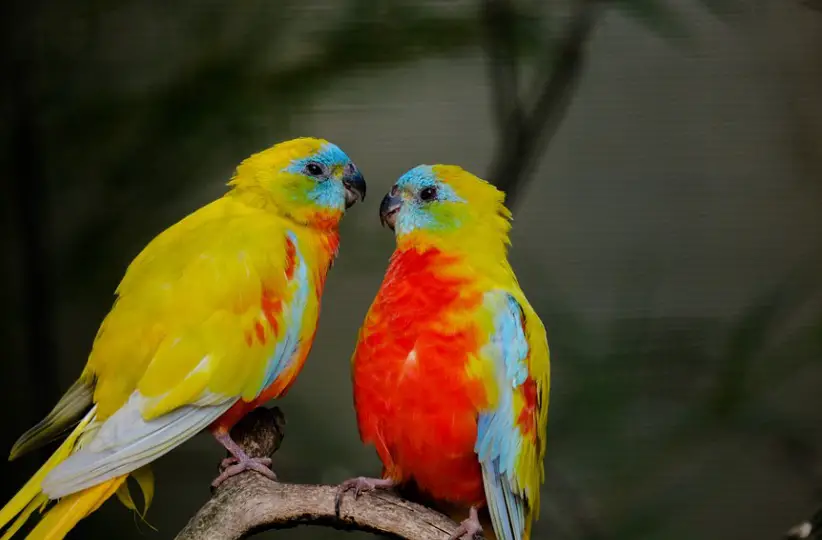Love Bird: All You Need To Know
The love bird is a short-tailed herbivore bird which belongs to the kingdom of Animalia, phylum Chordata, and class Aves. Its genus is Agapornis and it has 9 species. Its length is 10 to 16 cm and it weighs 56.7 g. It lives in various habitats, with a lifespan of 15 to 25 years.

Love Bird Description
Lovebirds (genus Agapornis) are chunky, short-tailed birds endemic to Sub-Saharan Africa and Madagascar’s woodlands and savannas. There are nine different species of lovebirds. Lovebirds are found in eight different species in Africa, with considerable overlap in their range.
The grey-headed lovebird (Agapornis canus), often known as the Madagascar lovebird, is the sole lovebird found on the island. Lovebirds are tiny parrots with usually green heads and necks, although some have orange, yellow, grey, black, or red on their heads and necks.
Their beaks are big and pointed, and they have a conspicuous ring around their eyes. The rosy-faced lovebird (A. roseicollis) is the biggest species, ranging across Africa from Angola to South Africa.

These birds are gregarious and dwell in groups, and they forage together on occasion. They are herbivores who eat seeds, fruits, and berries as part of their diet. Some species are generalists that will consume whatever they can find, while others are specialists who exclusively eat specific plant materials.
They live in holes drilled in trees, rocks, and plants. Some species couple up and build their nests far from the flock, while others pair off and build their nests separately. Lovebirds are monogamous and will stay together for the rest of their lives.
Although certain species are known to dance and sing to win the female over, the male will typically woo her by offering her little amounts of food. The female will deposit 4 to 6 eggs during the mating season, which will incubate for around 20 days. After the chick hatches, both parents look after it until it is ready to fly, which is approximately one month old.

Lovebirds are reported to be preyed upon by lanner falcons (Falco biarmicus), who may frequently take refuge in thorny shrubs to avoid capture. Habitat degradation and capture for the pet trade are two more dangers to lovebirds. Due to their tiny size, vibrant colours, and great vitality, lovebirds are popular pets.
They’re also known to be quite loving, especially if they’re kept alone and form bonds with humans. Despite concerns such as habitat loss, six species of lovebirds are classified as least concern. The black-cheeked lovebird, on the other hand, is considered fragile, while the Nyasa and Fischer’s lovebirds are considered near threatened.
Fun Facts About Love Bird!
These lovely tiny parrots have a variety of biological characteristics that make them exceptionally well suited to their surroundings. Lovebirds are one of the tiniest genuine parrot species, and they are very agile fliers that can do acrobatics in the air. Let’s look at it more.
Head Movements During Flying
Lovebirds are known for their exceptional flying abilities, including the ability to move rapidly in congested environments. Researchers utilized high-speed cameras to film the birds in order to figure out what makes them such quick and agile flyers.
The researchers discovered that these birds can shift their heads quite rapidly thanks to the film they obtained. Lovebirds can move their heads up to 270 degrees in as little as 2700 seconds, which is faster than insects! This is one of the quickest animal movements ever seen!
They can see in all directions when in the air because to their capacity to move their heads at super-fast rates. This gives these birds more time to perceive and respond to their surroundings, reducing the risk of accidents and allowing them to maintain a clean line of sight when twisting and turning during flight.
Love Bird Beak Adaptations
The beak of a lovebird is strong and hooked, like that of a parrot. It resembles the bills of hawks and owls from a distance, but the top and lower mandibles have a sharper, more uniform curvature. The lovebird’s hooked upper jaw fits into the lower mandible like a jigsaw puzzle piece.
Because of its food, the lovebird’s broad, strong bills have developed, allowing them to break seeds and rip through fruits. Because the beak is comprised of keratin, it may continue to expand. The birds will bite on hard things like branches to keep their beaks at the proper length and sharpness.
Monogamy
Monogamy is a fascinating animal trait that is seen across the animal kingdom. It most likely developed when both parents were there and the children had a far higher chance of survival. Monogamy is well-known among lovebirds. The birds establish close connections and are frequently seen feeding and pruning one another.
Lovebirds create lifelong mating partnerships, which means they can be together for up to 15 years! About 90% of bird species are monogamous, but unlike lovebirds, this may only be for a single or several mating seasons. Lovebirds create lifelong mating partnerships. Being monogamous has a number of benefits.
The first advantage is that the birds may share parenting duties. After she has laid the eggs, the female will sit on her nest and incubate them for three weeks. The guy will bring her food during this period. The mother will stay with her brood once the chicks have hatched, while the male will go food gathering.
This implies that one parent is always capable of protecting the chicks from predators. A second benefit is that once the birds have formed a relationship, they will not have to expend energy looking for a mate. If the birds‘ relationship is strong enough, there’s no use in spending energy looking for a new partner at the start of the mating season.







